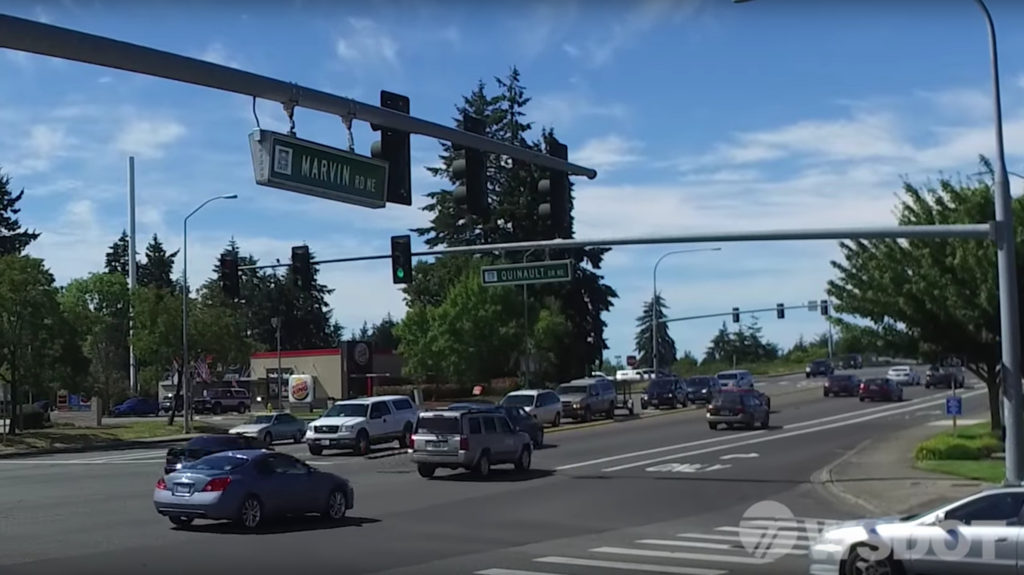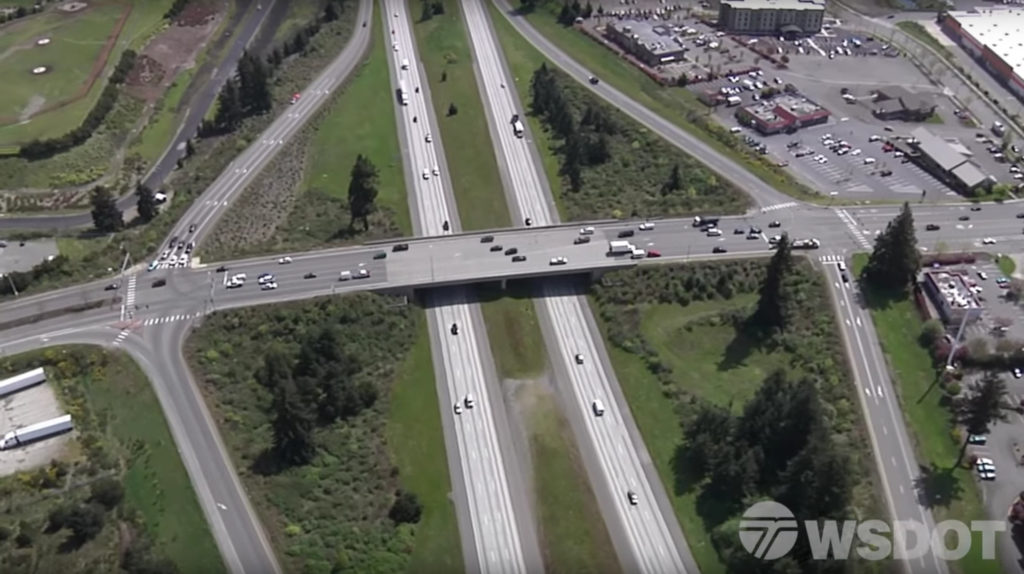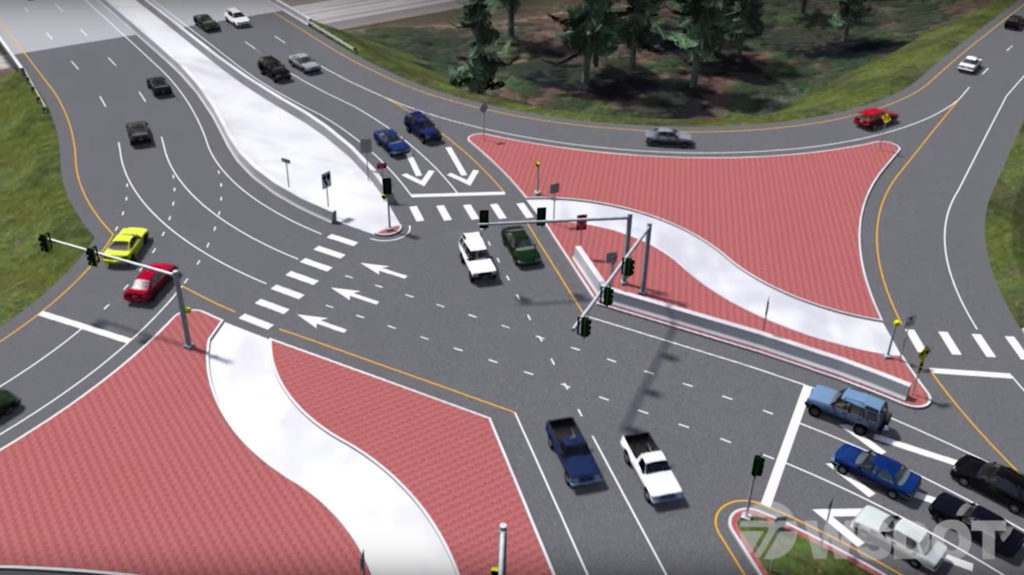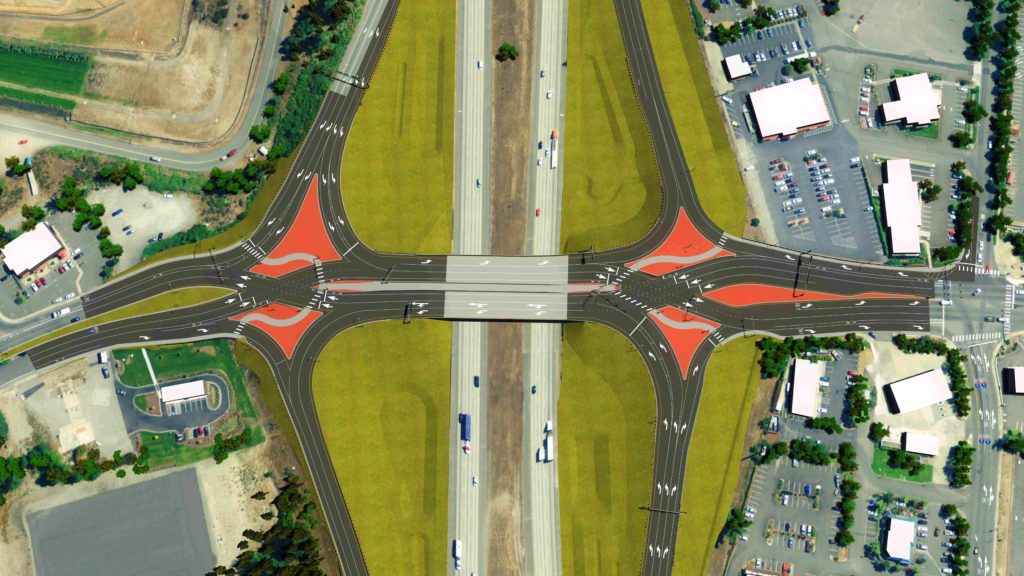The Washington State Department of Transportation and the City of Lacey will be building Washington’s first ever Diverging Diamond Interchange (DDI) at the I-5/Marvin Road overpass off exit 111 in Hawks Prairie.

Roger Schoessel has been an engineer for the City of Lacey since 1999 when the growth projections for Lacey and the surrounding areas were just coming into focus. He says that in 1997, a transportation study was done noting that the interchange at Marvin Road (exit 111) was undersized to accommodate the area’s future growth. “We knew we had to do something,” Schoessel says. “It’s better to stay ahead of growth than to fall behind and play catch up.”
Schoessel recalls a time when Marvin Road was a humble two-lane road, transporting about 7,000 cars per day. Today, that number is well up to 35,000 cars per day traveling on the expanded Marvin Road and into the booming Hawk’s Prairie area.
Phase one was first implemented in 2000, where a traditional diamond interchange was built, which is what you see today. But, Schoessel says, the city and state transportation departments knew that based on population growth projections, traffic and congestion issues would be inevitable by 2020.

In 2006, WSDOT, the City of Lacey, and the Federal Highway Administration all came to the table to discuss options for the busy Marvin Road interchange. A single-point urban interchange, or SPUI, was considered as well as the recently implemented DDI concept. Schoessel says that while both the SPUI and DDI performed well in tests, the cost difference was significant. “The SPUI requires a much larger bridge deck than what we had at exit 111,” he adds. “We looked at a lot of data, and once we saw the success other cities were having with the diverging diamond style interchange, we arrived on the DDI being the best, most cost-effective option for this area.”
While new to Washington, the DDI was already a proven and effective interchange in use across the country. The first DDI was implemented in Missouri in 2009. Since then, there have been more than 80 constructed in the United States. The proven safety, efficiency, and cost effectiveness has made the DDI a popular choice for upgrades to existing high-volume interchanges.

How Does it Work?
Doug Adamson of WSDOT communications says that while the interchange may be hard to explain it will be easy to use.
According to a WSDOT informational video, traffic signals in a traditional diamond interchange require three phases to manage traffic movements, including a separate left turn phase. In contrast, the DDI has thru traffic and left turns happening at the same time, eliminating the need for a separate left turn phase. This creates shorter wait times and allows the interchange to handle higher traffic volumes more efficiently. Safety is improved by reducing the number of potential conflict points within the interchange where traffic either merges, crosses or diverges from 26 points to 14, which has been shown to reduce collisions by 50 percent.
“This interchange is designed to be intuitive,” Adamson says. “Drivers will do what they already are doing: following the signs and lines. There will be clear lane markings and traffic lights that will guide drivers through the new interchange.”
The largest benefit for drivers is free left turns onto the highway. Due to the innovative design, drivers will not need to stop before getting onto I-5
Adamson says this is not just about cars and trucks. Bicyclists and pedestrians also will benefit from the inclusive interchange improvements.
“Cyclists get a choice,” he says. “They can either use bicycle lanes going in both directions or they can follow the pedestrian route that uses a series of crosswalks. There also will be a protected divider in the middle of the overpass where both bicyclists and pedestrians can travel.”

The funding has all been approved via a transportation package for the $72 million construction project, with construction due to start end of summer/early fall 2018, and completion scheduled for 2020.
While drivers can expect short- and long-term ramp closures, WSDOT is working to balance the needs of keeping traffic moving with the needs of construction, with crews working nights whenever possible. To stay informed, WSDOT recommends subscribing to receive email alerts for construction impacts and updates. I5exit111.com is also another prime source of information for this project.
At the end of the day, the I-5 Marvin Road Diverging Diamond Interchange is designed to provide better mobility for motorists, commercial vehicles, pedestrians and bicyclists alike, while simultaneously decreasing travel times and traffic congestion. The improvements to the interchange will most assuredly provide a balanced solution that improves safety while keeping people moving into the next wave of growth.
If you have questions, feel free to contact Adamson by emailing adamsod@wsdot.wa.gov or by calling 360-357-2716.
Sponsored


















































